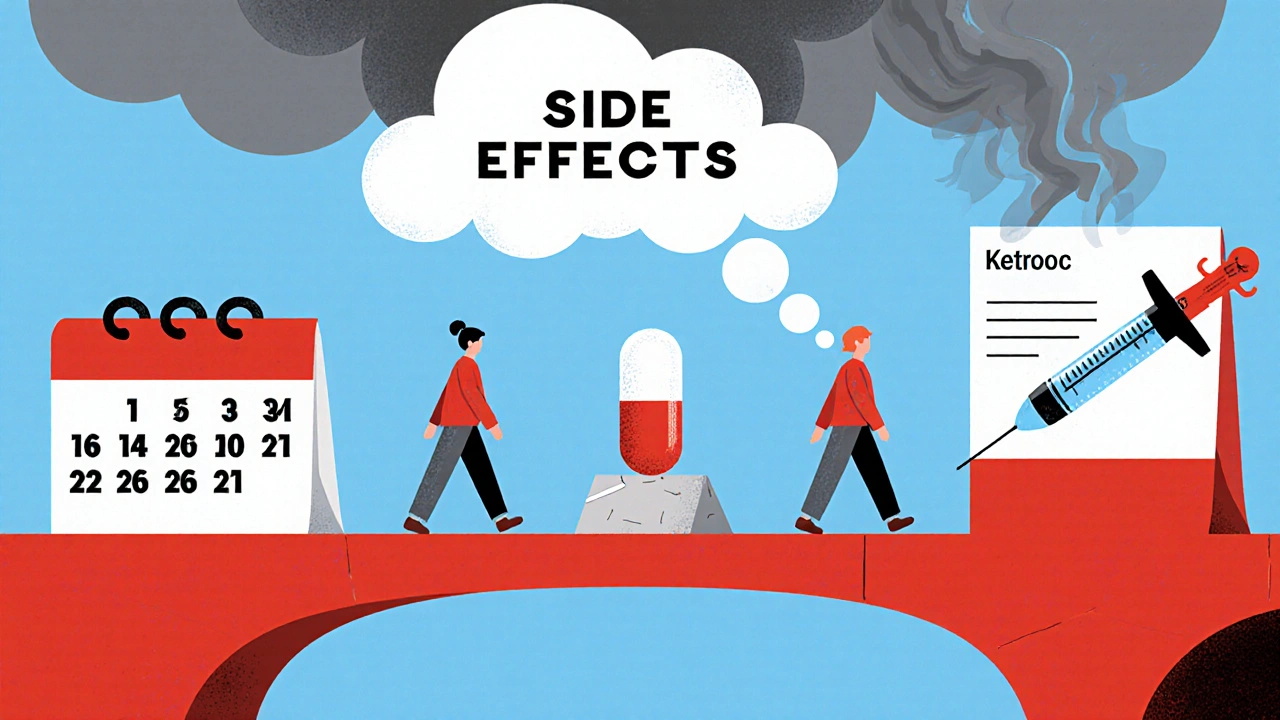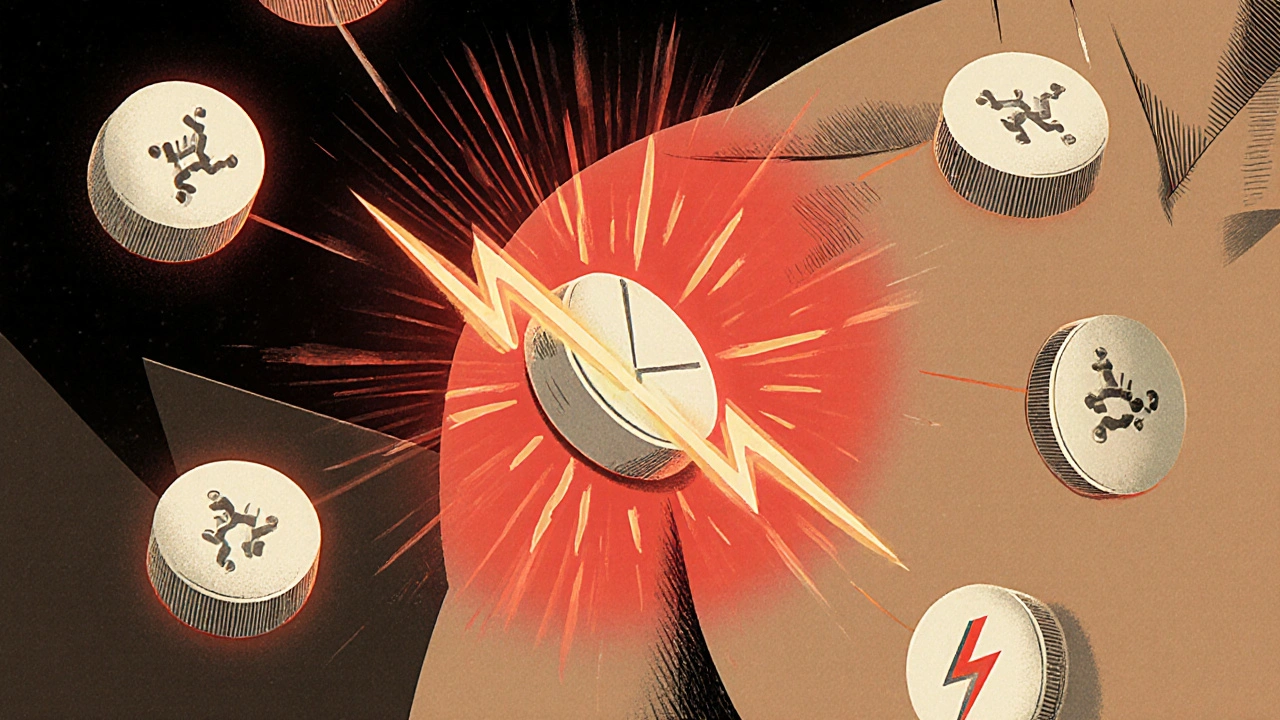When cancer spreads or tumors press on nerves and tissues, the pain can be severe, constant, and hard to control with regular painkillers. Many patients turn to stronger medications, but not all options are right for everyone. One drug that’s often overlooked but plays a real role in cancer pain management is ketorolac tromethamine. It’s not a narcotic, it doesn’t cause addiction, and it works fast - but it’s not a cure-all. Understanding how and when it’s used can help patients and caregivers make smarter choices.
What Ketorolac Tromethamine Actually Is
Ketorolac tromethamine is a nonsteroidal anti-inflammatory drug, or NSAID. It’s the same class as ibuprofen or naproxen, but much stronger. It blocks enzymes called COX-1 and COX-2 that trigger inflammation and pain signals in the body. Unlike opioids, it doesn’t act on the brain’s reward system, so there’s no risk of dependence or euphoria.
It’s available as an injection, oral tablet, or nasal spray. In hospitals, it’s often given intravenously right after surgery or during acute pain flare-ups. For cancer patients, it’s usually prescribed in tablet form for short-term use when pain isn’t fully controlled by acetaminophen or weaker NSAIDs.
The key difference between ketorolac and other NSAIDs? It’s approved for short-term use only - no more than five days for oral use and three days for injections. That’s because long-term use increases the risk of serious side effects like stomach bleeding or kidney damage. For cancer patients, this time limit makes it a bridge, not a long-term solution.
Why Doctors Choose Ketorolac for Cancer Pain
Cancer pain isn’t just one kind of pain. It can be bone pain from metastases, nerve pain from tumors pressing on nerves, or inflammation from swelling around tumors. Opioids help with all types, but they come with side effects: drowsiness, constipation, nausea, and mental fog. Many patients want to avoid those if they can.
Ketorolac shines in cases where inflammation is a major driver of pain. For example, a patient with breast cancer that’s spread to the ribs may feel sharp, aching pain with every breath. That’s often caused by tumor-induced inflammation in the bone. Ketorolac reduces that swelling, cutting pain without the sedation of morphine.
A 2023 study in the Journal of Pain and Symptom Management tracked 127 cancer patients who were switched from opioids to ketorolac for localized bone pain. Nearly 60% reported equal or better pain control, and 72% said their mental clarity improved. They could eat better, walk more, and talk with family without feeling drugged.
It’s also used alongside opioids in a technique called multimodal analgesia. Instead of relying on one drug, doctors combine low-dose opioids with ketorolac and sometimes antidepressants or anticonvulsants. This reduces the total opioid dose needed, lowering side effects and risk of tolerance.
Who Should Not Use Ketorolac Tromethamine
Ketorolac isn’t safe for everyone. Certain health conditions make it dangerous.
- People with active stomach ulcers or a history of gastrointestinal bleeding - ketorolac can cause life-threatening bleeding.
- Patients with advanced kidney disease - NSAIDs reduce blood flow to the kidneys, which can worsen function.
- Those taking blood thinners like warfarin or aspirin - combining them with ketorolac increases bleeding risk.
- Patients with heart failure or severe hypertension - NSAIDs can cause fluid retention and raise blood pressure.
- Anyone allergic to aspirin or other NSAIDs - cross-reactivity is common.
Also, it’s not recommended for patients with low platelet counts, which is common in advanced cancer or after chemotherapy. Platelets help stop bleeding, and ketorolac interferes with their function. Even if the patient isn’t bleeding now, the risk spikes during procedures or if a tumor erodes into a blood vessel.
Doctors always check kidney function and blood counts before prescribing it. If a patient’s creatinine level is above 1.5 mg/dL or their platelets are below 100,000, ketorolac is usually avoided.

How It Compares to Other Pain Options
| Medication | Works Best For | Duration of Use | Main Risks | Can Be Combined With Opioids? |
|---|---|---|---|---|
| Ketorolac tromethamine | Inflammatory bone pain, localized swelling | Up to 5 days (oral) | Stomach bleeding, kidney damage | Yes - reduces opioid dose |
| Morphine | Severe, widespread, neuropathic pain | Long-term | Constipation, drowsiness, addiction | Yes - but higher risk of side effects |
| Acetaminophen | Mild to moderate pain, no inflammation | Long-term | Liver damage at high doses | Yes - very safe combo |
| Gabapentin | Nerve pain from tumors or chemo | Long-term | Dizziness, fatigue, swelling | Yes - often used with NSAIDs |
| Corticosteroids (e.g., dexamethasone) | Swelling around tumors, spinal cord compression | Short to medium-term | Bone loss, high blood sugar, mood changes | Yes - but not for long-term use |
Notice how ketorolac fits in the middle: stronger than acetaminophen, less risky than opioids for long-term use, but not meant to replace them. It’s a tool for specific situations - not a universal solution.
Real-World Use: What Patients Experience
One 68-year-old man with prostate cancer that spread to his spine was on oxycodone 10 mg every 4 hours. He was constantly sleepy, couldn’t eat, and barely walked. His oncologist added ketorolac 10 mg three times a day, while reducing oxycodone to 5 mg every 6 hours. Within 48 hours, his pain score dropped from 8/10 to 3/10. He started eating again, took short walks outside, and said he felt like himself for the first time in months.
But it didn’t last. After five days, his doctor had to stop ketorolac because his creatinine level rose slightly - a sign his kidneys were under strain. His pain crept back up. The team then added gabapentin for nerve pain and switched to a low-dose fentanyl patch. He stayed comfortable for weeks.
This pattern is common. Ketorolac gives a quick, clear win - but it’s temporary. Its value isn’t in being the final answer, but in creating space: space for healing, space for better sleep, space for patients to reconnect with loved ones.

When Ketorolac Is a Mistake
Some patients are given ketorolac because it’s cheap or easy to prescribe. That’s dangerous.
A 2024 review in The Oncologist found that 22% of cancer patients prescribed ketorolac had no clear inflammatory component to their pain. In those cases, the drug did nothing - but still caused stomach upset or kidney stress. One patient developed a bleeding ulcer after 4 days on ketorolac, even though he had no prior stomach issues.
Doctors need to ask: Is the pain coming from swelling? Is there redness, warmth, or tenderness in one area? Is it worse with movement or breathing? If the answer is no, ketorolac won’t help. Better to try acetaminophen, gabapentin, or a low-dose opioid instead.
Also, don’t use it for chronic pain. If a patient needs pain relief for more than a week, ketorolac should be replaced. There are safer long-term options. Pushing it beyond five days doesn’t make the pain go away - it just increases the chance of hospitalization.
What Patients Should Ask Their Doctor
If ketorolac is suggested, ask these questions:
- Why are you choosing this over other options?
- Is my pain likely caused by inflammation?
- What are my kidney and stomach health like right now?
- How long will I be on this, and what happens after?
- What signs should I watch for that mean I need to stop?
Patients should also report any black stools, vomiting blood, swelling in the legs, or sudden decrease in urine output. These are red flags that need immediate attention.
Bottom Line: Ketorolac Has a Place - But Only a Small One
Ketorolac tromethamine isn’t a miracle drug for cancer pain. It won’t fix everything. But when inflammation is the main problem, it can make a real difference - fast, without the fog of opioids. Its power lies in its precision: short-term, targeted use in the right patients.
For many, it’s the missing piece between acetaminophen and morphine. It gives them back a few days of clarity, mobility, and dignity. But it’s not a lifeline - it’s a stepping stone. Use it wisely, monitor closely, and never extend it beyond the limit. When used correctly, it’s one of the most underappreciated tools in cancer care.
Can ketorolac tromethamine cure cancer pain?
No, ketorolac tromethamine does not cure cancer pain. It only reduces pain caused by inflammation, such as swelling around tumors or bone metastases. It doesn’t affect the cancer itself or stop tumor growth. It’s a symptom reliever, not a treatment for the disease.
Is ketorolac better than opioids for cancer pain?
It’s not better overall - it’s better for specific cases. Opioids work for all types of cancer pain, including nerve and deep tissue pain. Ketorolac only helps if inflammation is involved. But ketorolac has fewer side effects like drowsiness and constipation. Many doctors use both together to reduce opioid doses and improve quality of life.
How long can you safely take ketorolac tromethamine for cancer pain?
The maximum safe duration is five days for oral tablets and three days for injections. Longer use increases the risk of stomach bleeding, kidney failure, and heart problems. Even if pain returns after five days, ketorolac should not be restarted without a full medical review. Other pain management options should be explored instead.
Does ketorolac tromethamine interact with chemotherapy?
Yes, ketorolac can interact with some chemotherapy drugs. It may increase the risk of kidney damage when used with cisplatin or ifosfamide. It can also lower platelet counts, which is dangerous if chemo already causes low blood cell counts. Always tell your oncologist about all medications you’re taking before starting ketorolac.
Can I take ketorolac tromethamine if I have a history of ulcers?
No. If you’ve ever had a stomach ulcer, gastrointestinal bleeding, or perforation, ketorolac tromethamine is contraindicated. NSAIDs like ketorolac block protective chemicals in the stomach lining, making ulcers more likely to bleed or worsen. Safer alternatives like acetaminophen or low-dose opioids should be used instead.
What are the signs that ketorolac is harming my kidneys?
Signs include reduced urine output, swelling in the ankles or feet, fatigue, nausea, and confusion. Blood tests showing rising creatinine or dropping eGFR (glomerular filtration rate) confirm kidney stress. If you notice any of these, stop the medication and contact your doctor immediately. Kidney damage from ketorolac can be permanent if not caught early.
